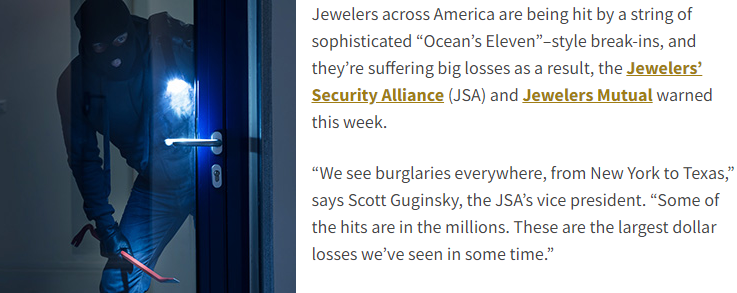September 18, 2024 – New York, NY

Howard Stone, vice president of global risk services and analytics for Jewelers Mutual, says the insurer started noticing an uptick in burglaries in June. “It doesn’t appear like they’re stopping,†he says.
Most of the thefts follow similar patterns. They generally occur on weekends. The gang members sometimes dress up as construction workers to avoid suspicion. They often come equipped with cellphone and Wi-Fi blockers. They usually cut the store’s power cables, and will sometimes wait for hours until the alarm’s backup battery runs out. On occasion, they’ll mount hunting cameras on the store, which act as motion sensors, to see if anyone’s coming.
The gangs are generally well prepared before they strike, gathering extensive intelligence about their targets.
“They usually roll into town for a week and do surveillance,†Guginsky says. “They scout out the store, follow the jeweler home. They often send someone in the store during business hours, with a camera on their hat and their shirt, so they have a sense of the layout.â€Â
Even though they have similar M.O.’s, multiple crews are committing these thefts, Guginsky says.
“They’re all from South America and they are somewhat in communication,†he says. “But it’s a loose-knit group. It’s not like there’s a [mob boss] John Gotti coordinating everything.â€Â
Guginsky notes that these gangs can function only when “jewelers are buying this stolen property.†(Fencing is, of course, a crime.)
To prevent burglaries, the JSA and Jewelers Mutual recommend jewelers take the following steps:
- Be aware of any suspicious customers or people who could be casing the store or following you. If you suspect someone is targeting your store, report it to both the JSA and local law enforcement. Keep a logbook that notes the time and date of suspicious activities.
- Regularly test security alarms and cameras.
- Review and update your emergency contact list, and ensure every person on this list clearly understands their role. Emergency contacts should be available even on weekends and holidays.
- Jewelers should notify the authorities about all alarm signals, including notices of communication errors or power interruptions. (Unexplained power cuts or cellphone outages are considered red flags.) Following an alarm, retailers shouldn’t enter the store alone but should wait for a police escort.
- TL 15×6– and TL 30×6-rated safes are no longer considered adequate protection from burglars. The JSA recommends TRTL 30×6–rated safes.
- Don’t position a safe on an outside wall or the wall of a neighboring office or store. That could enable burglars to penetrate the safe without entering the store.
- Don’t leave merchandiseâ€â€even inexpensive merchandiseâ€â€in showcases at night. Either lock it in the safe or find another way to keep it out of sight.
- Forge relationships with local law enforcement and mall security. Have them tour your store and identify potential vulnerabilities.
Article provided by Rob Bates, JCK Magazine. Click here to view the source of the article.










